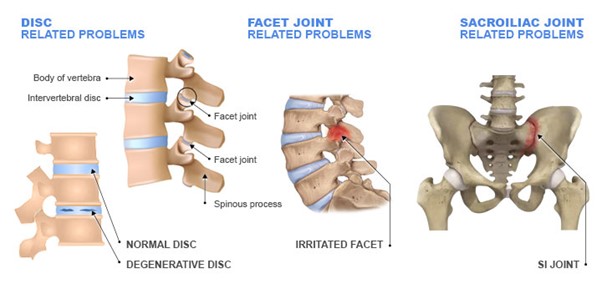Spinal pain
Spinal pain
Pain can affect any region of the spine, from the neck to the pelvis. Common sources of pain include the discs, facet joints or sacroiliac joints.

Musculoskeletal Medicine Physicians are experts in the assessment of spinal pain, and can arrange further investigations if necessary to determine the cause, such as:
- Imaging such as XRays, MRI or CT
- Precision diagnostic injections, such as medial branch or sacroiliac joint blocks
- Nerve conduction studies
Ultimately, treatment will depend on the suspected cause and can include:
- Medication
- Physical rehabilitation
- Steroid injections, including epidurals
- Radiofrequency ablation in the treatment of facet joint pain
- Radiofrequency ablation in the treatment of sacroiliac joint pain
Some examples are found below:
Whiplash
Did you know that the cause of pain in whiplash injuries to the neck is most commonly injury involving the facet joints? Furthermore, imaging is often normal. This is because not all injuries are seen of Xray, MRI, or other imaging modalities.
It’s a commonly held belief that ‘degeneration’ is the cause of pain – in actual fact, research is clear that degenerative changes are usually painless.
A diagnosis of facet joint pain is made using diagnostic injections (called medial branch blocks), selectively anaesthetising facet joints and assessing the patient’s response.
If a diagnosis of facet joint pain is confirmed, then treatment using Thermal Radiofrequency Ablation is often recommended, with a high chance of complete or significant pain relief for a sustained period.
Low Back/Buttock Pain
In around 70% of patients, a structural source of pain can be identified. Pain generally arises from:
- An intervertebral disc
- Lumbar facet joint
- Sacroiliac joint
Imaging may be normal, or demonstrate age related change (commonly called ‘degeneration). Remember – Xrays, MRI scans and other imaging modalities cannot demonstrate pain, only anatomy.
Additionally, it’s a commonly held belief that ‘degeneration’ is the cause of pain – in actual fact, research is clear that degenerative changes are usually painless.
So, often further diagnostic testing is necessary to identify the source of pain. This allows appropriate treatment to be planned.
A diagnosis of facet joint pain is made using diagnostic injections (called medial branch blocks), selectively anaesthetising facet joints and assessing the patient’s response.
If a diagnosis of facet joint pain is confirmed, then treatment using Thermal Radiofrequency Ablation is usually recommended, with a high chance of complete or significant pain relief for a sustained period.
We are able to offer all of these procedures, performing them strictly in accordance with international best practice.
Sacroiliac Pain
The sacroiliac joint (SIJ) is also a well recognised source of pain. Once again, imaging is often normal, and so the diagnosis is made by injecting a small amount of local anaesthetic into the joint – if pain resolves for the duration of action of the anaesthetic, then a diagnosis of SIJ pain is confirmed.
Treatment in the first instance is by way of an injection of steroid into the joint. This helps a proportion of patients, but not all – and it is not necessarily permanent.
An alternative treatment option is radiofrequency ablation of the nerves that supply the SIJ – called sacral lateral branch radiofrequency ablation.